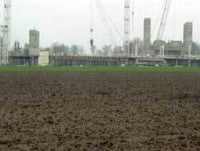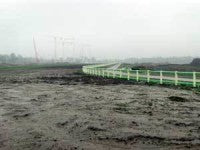Major_changes_at_Royal_Ascot
Major Changes at Royal Ascot
By David Warner, Course Manager

Ascot is all about horse racing. There has been racing here for almost 300 years. Our main event is obviously the Royal Ascot Festival, held in June each year. As most people already know, the 2005 event is being held at York because of the major work we are doing to the course.
We have two tracks at Ascot. We've got the flat track for our big festivals in the summer, the Royal event and the Diamond Weekend, and we've got the steeplechase and hurdle track, which is used, from October to March for the National Hunt Season.
As Course Manager I am responsible for all activities that involve the maintenance of the turf and landscape areas. My primary role is to ensure that the racing surfaces are safe and viable for racing.
I came here in December 2003 just as the major development works began. In addition to moving the track project forward, my task has been to look at the racing surface and, working with Buro Happold and the STRI, the designers of the profile, plan the new maintenance regimes that will be required.
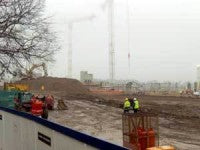
The size and scale of the development is quite staggering. There will be a realignment of the track; the straight mile will be moved 42 metres north of its current location. The new stand will be built further away from Ascot's High Street, thereby creating more space and ease of movement between the entrance gates and the stand. The whole project is costing approximately £185 million. The main works are: -
-
Knocking down the old main stand and rebuilding a brand new main stand facility.
-
Re-siting of parade rings and saddling boxes.
-
Re-building of entrances and car parking facilities.
-
Complete rebuild of the straight mile flat racing course.
-
Building of underpasses.
-
Complete refurbishment of the Chase course.
-
Removal of existing the golf course and the rebuilding of a new 18-hole parkland course.
-
Re-establish wild heathland into the course.
The re-alignment involves considerable civil engineering work undertaken by Raymond Brown followed by White Horse Contractors doing all the track rebuilds, including all the new drainage works. The turf for the flat course is supplied by Inturf and laid by Talbot Farm Landscapes. M J Abbots are installing the new irrigation systems.
I'm here at the course every day. We have weekly site meetings, track progress meetings where the managing directors and everyone else is involved.
The Straight Mile Flat Course.
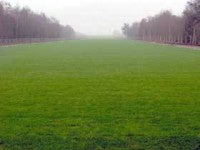
The topsoil at Ascot is classified as loamy sand which, unfortunately, has quite a high silt content and which has affected the drainage capabilities in the past. However, we have now had the opportunity to improve this situation on the flat course by ameliorating our topsoil with sand and installing drainage layers and piped drainage schemes.
The topsoil for the flat course was blended 50:50 with Kingsley sand. This sand was selected because of its particle size and ability to blend with the existing soil materials.
The track now consists of 200mm of the 50:50 mix, a 100mm profile of Kingsley number 1 sand, and a 50mm blinding layer and a 100mm gravel carpet over terram. The drainage system is 80mm diameter lateral drains spaced at 6m centres, which connect into 150mm outfall drains that run into open ditch systems.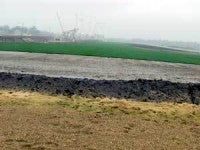
Over 65,000m2 of big roll turf have been laid to date. The turf is 60% perennial ryegrass, 20% smooth stalked meadow, 10% fescue and 10% strong creeping red fescue.
We expect the final turfing to be completed in May, which will give us a full year of growing in and maintenance before we begin racing on it in 2006.
The new irrigation system will be replacing the original irrigation pump, which was installed in 1932. Having done over 70 years of service it was time to upgrade. The whole system is designed to produce the optimum racing conditions, using the latest technology to give us the necessary information to make decisions regarding the amount of water we need to put on. The system will be linked into a weather station system. We have used Rainbird sprinkler heads; one of the reasons we selected these was the sheer height they come out of the ground, almost 100mm. With the grass length being 100mm, the height of the sprinklers means that the spray pattern will not be affected. The system is zoned so we have complete control over the surface consistency.
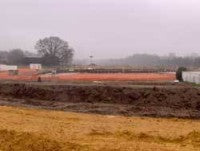
National Hunt Course
Over 40 % of the chase course has been re-constructed in much the same way as the Flat course - the exceptions being the use of a straight topsoil for the top 200mm and seeding with a 60% perennial ryegrass, 20% smooth stalked meadow, 10% fescue and 10% strong creeping red fescue instead of turfing. The remaining track will have new drainage installed at 6m centres with a total renovation of the turf surface to re-vitalise the existing sward, including: -
-
Regular mowing at a reduced height of 25mm to increase sward density.
-
Aeration using the Vertidrain.
-
Scarification.
-
Top dressing.
-
Feeding.
-
Overseeding.
-
Watering as required.
-
Final Preparations
We are scheduled to complete all track modifications and construction works by April 2005. This will give me a full year in which I can establish a strong sward density ready for the opening of the tracks in 2006.
I will also be monitoring and looking for new ways of managing and maintaining these new surfaces. Certain works will be different - I envisage a lot more vertical aeration because we are managing a surface that is relatively free draining. Previously it was drum-type spike aeration. Vertical aeration gives a good pattern and a nice surface without too much disruption, depth can be varied which enables good water penetration.
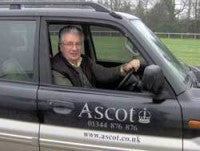
Our 2005 fixtures have been moved to other courses. I will be watching with interest how they go on, particularly the Royal event at York. I have been asked if I have had any input into the preparation of those courses, but absolutely not. All the racecourses involved have sufficiently talented groundstaff of their own. Anyway, I have too many responsibilities at this end, making sure this is all right and correct.
The attraction of my position is how to confront the challenges in front of me, how to resolve them and identify the solutions. The challenge of providing a consistent surface at one of the world's most famous racecourses is absolutely brilliant. The prospects for the future look very exciting.
In particular I am really looking forward to the day racing comes back to Ascot. It will be a fantastic spectacle.
Additional photographs of works undertaken.
|
|
View of the new stands during construction |
|
|
View of national hunt course in construction |
Information regarding the relocation and construction of the Royal Ascot Golf course will follow.

